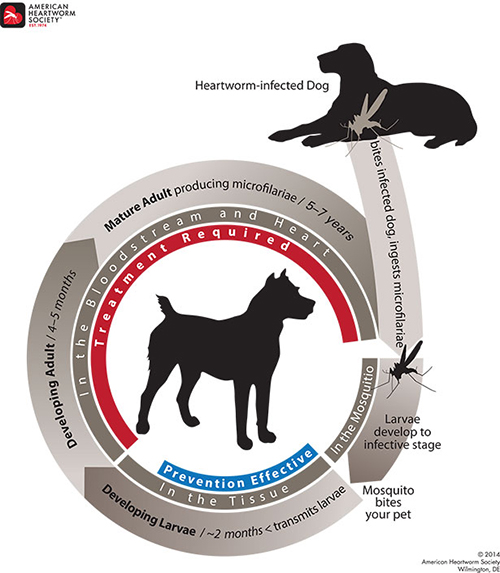Heartworm Disease: Why Your Pet Really Does Need Monthly Prevention
Heartworm disease, spread by mosquitoes, has been documented in all 50 states, and is considered endemic in 48 states. Both temperature and humidity play an important role in the life cycle of heartworms.
When a mosquito bites a heartworm-positive dog, the mosquito ingests the microfilaria (maggot stage of heartworm). Inside the mosquito, the microfilaria matures from a baby into a larva (little worm) and then injects the L3 larval stage back into dogs, infecting them with heartworms.
Below is a diagram of the life cycle of heartworms. Once infected, the worms can live five to seven years if they are never treated. You can also see that the monthly preventative is only effective at killing the developing larva (see blue “Prevention Effective” area). This is why it is so important to give prevention every month.

Watch a video of a heartworm case from one of our recent patients that shows microfilaria within the blood of a heartworm-positive dog.
Due to temperature and humidity playing an important role in the life cycle of heartworms, the transmission of heartworm disease is often limited to six to eight months in Chicago. For this reason, many people only give prevention during the “warm” months of the year. Only giving heartworm prevention during the “warm” months can place your dog at risk of developing this deadly disease. Below is an incidence map from the American Heartworm Society from 2016. As you can see, Chicago sees on average 26 to 50 cases/year per clinic.

How does heartworm prevention protect my dog?
When a dose of heartworm prevention is given to a dog (either topically or orally) it acts as a dewormer and kills off any of the possible larval stages that mosquitoes have transmitted to dogs. The medication is usually in and out of the dog’s system within 24 hours and does not stay in the dog’s body for 30 days. Heartworm prevention does not kill adult heartworms. It only kills the larval stages. This is why it is important to be given every 30 days because within 30 to 45 days post-exposure the larva can develop into juvenile adults, which the prevention is not effective at killing.
Why do I need to give prevention 12 months of the year, since the transmission of heartworm disease is limited to 6 to 8 months in Chicago?
There are two main reasons we recommend year-round prevention. First, there have been some studies that have shown that a single dose of heartworm prevention does not always kill off 100% of the larva, but repeated doses do kill 100%. Another reason monthly prevention is recommended is because most heartworm preventions also prevent intestinal parasites that can be spread to humans. Your dog can be exposed to these parasites by simply walking in areas where other animals (dogs or feral cats) defecate. When used monthly, your dog will also be dewormed against these parasites—roundworms and hookworms most commonly.
What if I miss a dose? Do I need to re-test before starting back on prevention?
If you miss a dose of prevention or are late giving it, just give it as soon as you remember. The annual heartworm test performed at annual wellness visits test for adult heartworms, and a single missed dose could lead to possible heartworms, but due to the life cycle it would take six to seven months for that test to show up positive. Therefore, we recommend if you miss a dose just start it back up as soon as possible and be sure to have your annual test completed within the next year to be sure that your dog did not get exposed to heartworms during the period in which he/she was unprotected.
Is heartworm disease considered contagious?
Not really. A dog can’t spread heartworms to another dog directly. A mosquito is always needed for transmission. With that in mind, having a heartworm-positive dog in the area does increase the risk for exposure as many mosquitoes may be infected with heartworm, waiting to transmit the disease to their next victim.
Drew Sullivan, DVM, Director
Medical District Veterinary Clinic

